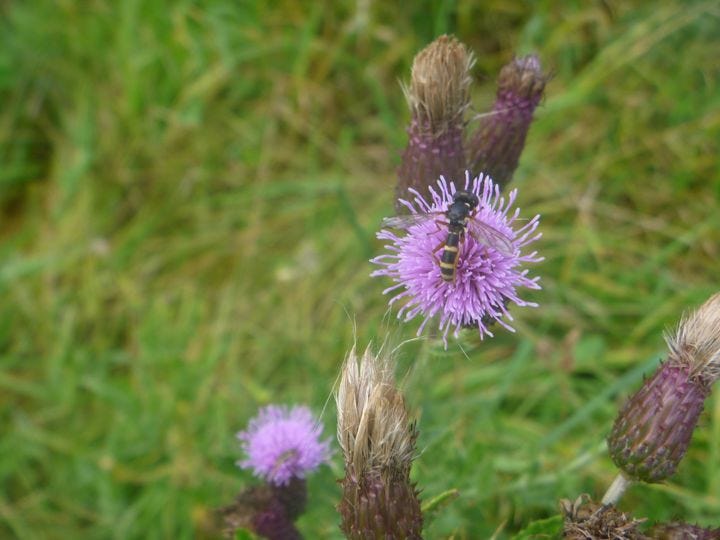I always like to keep my eye out when walking in nature. My first interest in nature was birdwatching, as it is for many people. When I was young, the Observers books of Birds was quickly followed by those for Butterflies and Wildflowers. I studied Botany at University, and only more recently developed an interest in insects beyond butterflies, helped by my partner who has always been interested in many types of insects. I've got a particular interest in hoverflies, harmless insects, many of which mimic bees or wasps. It's a good group of insects to be interested in, as, once you've got your eye in, there are several easily recognised species, to give you confidence in your identification skills, then a good number that are more challenging. There are 260 species of hoverfly in the UK, which feels manageable (though I doubt I'll ever be confident about identifying even a fraction of that number, or even being lucky enough to see all the UK species).
When my partner and I were out the weekend before last, we came across this insect, which we've never seen before or at least never had a good look at before:
We recognised it immediately as some sort of fly (it has only two wings, so is a Diptera, the scientific name for all flies, which means 'having two wings'). I thought it might be a hoverfly, because it's fairly clearly a wasp mimic.
When we got home, I looked this fly up in the Nature-Spot gallery of UK hoverflies, but couldn't find it. Was I missing something or was it a species that isn't in that particular gallery? So I posted its photo into Facebook's UK Hoverfly group, where it was identified as a Conopid fly and I was referred to the Facebook Conopid group, where I was told it was a male Conops quadrifasciatus! So that's not just a species I've never knowingly seen before, but a whole group of flies, the Conopids or Thick-headed flies that I'd never previously been aware of.
Funnily enough, the following Tuesday, I was doing a butterfly survey at the Edinburgh Agro-ecology Project and saw this insect:
This looks familiar I thought (though not identical) so when I got home I looked it up on the Nature Spot Conopids page, and worked out it was probably a female Conops quadrifasciatus, which was proved to be correct when I posted the photo above into the Facebook Conopid group.
I'm very pleased to have added a new insect to my own personal species list. I enjoy the exercise of trying to identify a species I’ve not seen before, it’s like solving a puzzle. Some are trickier than others and sometimes I do give up entirely, or stop at a more general level than species.
Of course, identifying unfamiliar sightings to species level isn't for everyone! It's essential if you're going to get involved in wildlife recording (see my previous post here) and wildlife recording is important for all sorts of reasons. However, it's perfectly possible to enjoy nature without being able to give a name to everything you see.
**
Thanks for reading Crafty Green Poet. Subscriptions are currently free for everyone, but if you’d like to show your appreciation, you can buy me a coffee and help me support independent cafés in Edinburgh. Click on the button below!
What I’m Reading
Mathematics of Life by Ian Stewart - a fascinating book about maths, biology and ecology, written in a very readable style.
Join in!
This autumn, help Plantlife find Britain’s most colourful and important fungi – waxcaps. Take part in Waxcap Watch.
What’s On
Edinburgh’s Royal Botanic Gardens are hosting a couple of interesting exhibitions:
Fungi Forms, open until 8 December, uses the arts to explore fungi in science, culture and innovation.
Ash Rise, open from 13 September to 12 January 2025, showcases the work of makers and crafters and celebrates the ash tree and highlights the effects of ash dieback.
The National Library of Scotland has just published its Autumn events programme. Highlights include:
The Sustainability Fair on Friday 27 September.
Climate Change Collections Showcase on Tuesday, 8 October.
Nature Crafts Family Workshop on Saturday, 12 October.
Remember a Charity Week 9 - 15 September 2024
Find out how to leave a legacy to protect Scotland’s wildlife on the Scottish Wildlife Trust website.
Other charities also join in Remember a Charity Week, so you can choose which charity to support.
Good News
‘Better than medication’: prescribing nature works, project shows, article in the Guardian
Bad News for Nature
England’s nature-friendly farming budget to be cut by £100m in the Guardian.
An update on avian flu from the Guardian.






When I first encountered a shield bug, I wondered if I'd chanced upon some sort of alien creature. It was exciting and scary. Fair enough, I was a child, but it's stuck with me through the decades, so I was able to imagine with glee at your excitement of finding something new in your adventures. Thank you for sharing!
While I'm an inveterate nature lover and enjoy nothing more than exploring the gardens, fields, forests and countryside around me, I'm content to observe and photograph the life forms surrounding me without being able or inclined to identify them. I have general categories: bees, flies, Butterflys, bugs, caterpillars, birds, trees, grasses, worms etc. To be sure, I can identify many of the creatures I espy but if not, I'm content to say how-do-you-do and simply ponder.